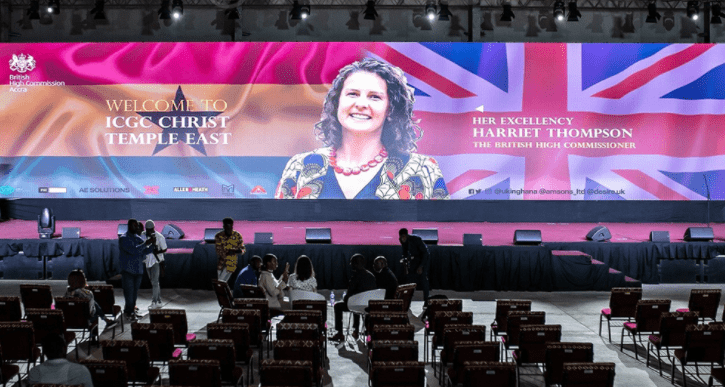How to Choose the Most Cost-Effective Stage LED Display Screen
Selecting the most cost-effective stage LED screen requires balancing price, ผลงาน, และ specific event needs. While budget is important, you must ensure the screen delivers ภาพที่มีคุณภาพสูง, durability, และ versatility for various applications. Below are detailed guidelines to help you make the best choice:

1. Understand Your Event Needs
Before deciding on a screen, consider the following factors:
Event Type
- ในร่มหรือกลางแจ้ง:
- Indoor screens typically have lower brightness and may cost less, while outdoor screens require higher brightness and weatherproofing, increasing their price.
- Temporary or Permanent Installation:
- For เหตุการณ์ชั่วคราว, lightweight and portable rental screens are ideal, while fixed installations require more durable and long-lasting designs.
Audience Size and Viewing Distance
- พิกเซลพิทช์:
- Choose the pixel pitch based on the viewing distance:
- P1.56–P3.9: For close-up viewing (1–4 meters).
- P4.8–P6: For medium distances (5–10 meters).
- P8–P10: For long-distance viewing, such as outdoor concerts or stadiums.
- Choose the pixel pitch based on the viewing distance:
- Smaller pixel pitches provide sharper visuals but are more expensive.
Screen Size and Resolution
- Larger screens require more panels, increasing costs.
- High resolution (e.g., Full HD, 4K) is essential for high-profile events, but smaller resolutions may suffice for basic presentations.
2. Evaluate Key Features
The right features can save costs in the long run by ensuring durability, energy efficiency, and ease of use.
ความสว่าง
- Indoor Screens: 800–1500 nits.
- Outdoor Screens: 4000–8000 nits to ensure visibility in bright sunlight.
อัตราการรีเฟรช
- A refresh rate of 1920Hz–3840Hz ensures smooth visuals for live streams และ จอแสดงผลที่เป็นมิตรกับกล้อง.
ประสิทธิภาพการใช้พลังงาน
- Look for screens with low-power LEDs and energy-saving technologies to reduce electricity costs over time.
Ease of Installation
- ระบบล็อคด่วน and lightweight panels reduce labor costs for setup and teardown.
ความทนทาน
- Outdoor screens should have กล่องหุ้มที่ได้รับการจัดอันดับ IP65 for waterproofing and dust resistance.
- Ensure the screen is made from strong materials like die-cast aluminum for long-term use.
3. Compare LED Screen Types
LED screens come in different types, each with unique pricing and features:
SMD (Surface-Mounted Diode) LED
- Best For: Indoor and some outdoor applications.
- ค่าใช้จ่าย: Affordable.
- ข้อดี: High resolution and wide viewing angles.
DIP (Dual In-Line Package) LED
- Best For: Harsh outdoor environments.
- ค่าใช้จ่าย: Slightly higher than SMD LEDs.
- ข้อดี: Better durability and brightness.
จอ LED แบบโปร่งใส
- Best For: Creative and modern stage setups.
- ค่าใช้จ่าย: Higher than standard screens.
- ข้อดี: Allows light and visibility through the screen for unique effects.
Flexible LED Screens
- Best For: Curved or creative stage designs.
- ค่าใช้จ่าย: Higher than flat panels.
- ข้อดี: Versatile and visually impactful.
4. Calculate Total Cost of Ownership (TCO)
The upfront purchase price is only part of the total cost. Consider the following:
Initial Purchase Price
- Budget-Friendly: Opt for larger pixel pitches (e.g., P6, P8) and standard configurations.
- High-Quality: Smaller pixel pitches (e.g., P2.6, P3.9) cost more but provide superior visuals.
Installation Costs
- Screens with ระบบล็อคด่วน and lightweight panels save on labor.
การบริโภคพลังงาน
- Choose energy-efficient screens to lower electricity bills, especially for long-term installations.
Maintenance and Spare Parts
- Modular designs with front/rear access reduce maintenance costs.
- Check warranty terms for repairs and replacements.
Rental vs. Purchase
- ให้เช่า: Suitable for one-time or occasional use. Saves on upfront costs.
- Purchase: More cost-effective for frequent use or permanent installations.
5. Research Suppliers and Manufacturers
Choose a reliable supplier to ensure quality and after-sales support.
Compare Prices
- Request quotes from multiple vendors to compare prices and features.
- Beware of deals that seem too good to be true, as they may compromise on quality.
Check Certifications
- Look for certifications like CE, FCC, และ RoHS to ensure compliance with safety and quality standards.
Examine Warranty and Support
- Opt for suppliers who offer:
- At least 2–3 years warranty.
- 24/7 technical support.
- Spare parts availability.
Read Reviews and References
- Check customer reviews and ask for references to gauge the supplier’s reputation and product reliability.
6. Opt for Modular Designs
Invest in modular LED screens for scalability and flexibility:
- You can expand or reconfigure the screen for different events, maximizing its value.
- Modular panels are easier to maintain and repair, reducing service costs.
7. Look for Rental Options
If purchasing is not feasible, consider renting:
- ข้อดี:
- Lower upfront cost.
- Access to the latest technology without long-term commitments.
- ข้อเสีย:
- May cost more in the long run for frequent use.
8. Negotiate for Bulk Discounts
If purchasing multiple panels or a large screen, negotiate with the supplier for bulk discounts หรือ package deals that include installation and maintenance.
9. Focus on Long-Term ROI
While the cheapest screen may save money initially, investing in a durable, energy-efficient, and high-performance screen provides better ROI through:
- Lower maintenance costs.
- Longer lifespan.
- Higher audience satisfaction.
10. Avoid Common Pitfalls
- Ignoring Viewing Distance:
- Choosing the wrong pixel pitch can result in poor visuals.
- Overlooking Maintenance Costs:
- Cheap screens often have higher repair and maintenance expenses.
- Buying Without Testing:
- Always request a demo or sample to evaluate brightness, resolution, and build quality.
บทสรุป
To choose the most cost-effective stage LED screen:
- Assess Your Needs: Determine the event type, audience size, and viewing distance.
- Select Key Features: Prioritize brightness, pixel pitch, and energy efficiency.
- Compare Suppliers: Evaluate multiple options to find the best balance of price and quality.
- Consider Long-Term Costs: Factor in installation, energy, and maintenance expenses.
- Choose Reliability: Opt for durable, modular screens with strong warranties and support.
Need Help Choosing the Right LED Screen?
We offer customized solutions to help you find the most cost-effective LED screen for your stage. From consultation ถึง การติดตั้ง และ support, we ensure you get the best value for your investment.








